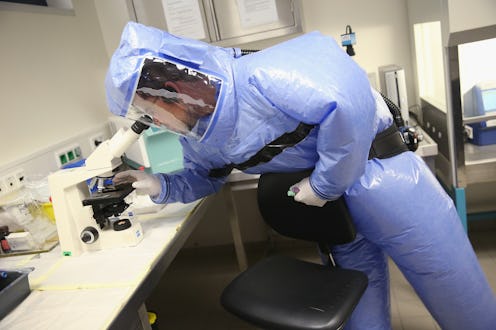News
Ebola And The Black Death? Not So Different

History does not paint the Middle Ages as a fun time. Between 1347 and 1352, a vicious plague known as the Black Death ravaged Europe, killing an estimated 20 million to 25 million people — almost a third of the population at the time. History classes have long taught that the Black Death was synonymous with the bubonic plague, a bacterial disease spread by fleas on rodents, but in the wake of the current Ebola outbreak in West Africa, researchers are discovering that the Black Death could have been an Ebolalike virus. I didn't think the Ebola situation could get any scarier, but it just did.
In their new book Biology of Plagues: Evidence from Historical Populations, researchers Christopher Duncan and Susan Scott make the argument that the Black Death was most likely caused by a hemorrhagic virus like Ebola, rather than the bacteria related to the bubonic plague. The duo looked at everything from symptoms to the way the two diseases spread. In order to draw detailed comparisons between the medieval disease and modern Ebola, let's revisit history class.
The Black Death came to Europe by sea, after Genoese trading ships that had traveled to central Asia and through the Black Sea came back with a mostly dead crew. It's been long believed that the disease was caused by a bacillus called Yersina pestis and was spread by infected fleas on rats. In those days, ships were commonly infested by the rodents, and thus the disease spread easily from one European port to another.
So how does it compare to the Ebola virus that is currently devastating West Africa?
Horrific Symptoms
Brace yourself: The Black Death earned its ominous name from the black liquid that seeped out of swollen lymph nodes on the afflicted. The swollen areas, which are also known as buboes, were a defining characteristic of the disease and they usually occurred in the armpit and groin areas.
If infection reaches the blood stream, it severely damages the organs and causes blood vessels to hemorrhage, which then results in bleeding from the nose and ears and vomiting blood. These extreme symptoms are also accompanied by flulike symptoms, including fever, headaches, chills, and weakness.
Similarly, Ebola, which was formerly known as Ebola hemorrhagic fever, also starts out with flulike symptoms, including fever, headaches, and muscle aches. And like the Black Death, Ebola victims often go through a bleeding phase that can result in vomiting or coughing up blood and bleeding from the eyes, nose, and mouth.
How They're Spread
One of Scott and Duncan's main arguments is that the Black Death was not spread via fleas and rodents, as historians have long believed, but rather from person to person, like Ebola. They note in their book that quarantining Black Death victims effectively stopped the spreading of the disease, which would not have been possible if it was spread by rats.
"If you look at the way it spreads, it was spreading at a rate of around 30 miles in two to three days," Duncan writes. "Bubonic plague moves at a pace of around 100 yards a year."
Mortality Rate
Despite the similarities, it seems that modern Ebola may be even scarier and more deadly than a disease called Black Death. According to Dr. David Dennis, coordinator of the plague program for the Centers for Disease Control and Prevention, victims of the Black Death, if untreated, had a mortality rate of 50 to 60 percent. Ebola, on the other hand, has a mortality rate of up to 90 percent.
Shudder.
Images: Wikipedia Commons, Getty (3)